Cleaning And Shaping Of Root Canal Important Notes
- Cleaning And Shaping Of Root Canal Step Back Method
- It is also called flare telescopic or serial root canal preparation
- Once the canal has been enlarged in the apical third to at least non-25, each consecutive larger root canal instrument used for shaping the canal is placed short of the apex
- This results in apical enlargement and marked taper from apical to corona;
Advantages: - Less chances of periapical trauma
- Facilitates removal of more debris
- The development of an apical matrix or apical stop prevents overfilling of the root canal
- Greater condensation pressure can be exerted which often fills lateral canals with the sealer
Disadvantages: - Apical extrusion of the debris through the apex
- Cleaning And Shaping Of Root Canal Modified Stepback
- The preparation is completed in the apical area and then the step back begins 2-3mm up the canal
- This gives a short almost parallel retention form to receive primary gutta-percha cone
- Cleaning And Shaping Of Root Canal Step-Down Technique
- It is called the crown down pressure less technique
- Gates Glidden drills or large-sized files are used in the control 2/3rd of the canal and progressively smaller files are used from the coronal preparation until the desired length is obtained
Advantages: - Eliminates the extrusion of the debris through the apex during instrumentation
- Achieves complete cleansing of the canal
- It helps in achieving a biocompatible seal at the apex
- Prevents post treatment discomfort
- Provides a coronal escape way that reduces the piston in-cylinder effect responsible for debris extrusion from the apex
Read And Learn More: Endodontics Question and Answers
Obturation Of Root Canal
- Cleaning And Shaping Of Root Canal Hybrid Technique
- Proposed by Goeing and Buchanan
- Uses both step down and step back technique
- The coronal portion is enlarged by step down technique
- The apical portion is enlarged by the back technique
- Cleaning And Shaping Of Root Canal Balanced force concept
- Uses flex-R-file with the non-cutting tip
- Reaming action using clockwise insertion and counter clockwise cutting and removal with apical force
- The entire preparation steps down beginning with flaring of coronal and mid thirds of the canal with Gates Glidden drills 1-6
- It involves placement, cutting, and removal using only rotary motion
- Apical pressure application is adjusted to match the file strength
- Clockwise rotation which sets the instrument should never exceed 180°
- Counterclockwise rotation with apical pressure is 120° or greater
- By these actions, the instrument advances toward the apex
- With this technique problems of instrument breakage and root perforations are encountered
- Cleaning And Shaping Of Root Canal Cleaning And Shaping Of Root Canal Principles Of Root Canal Preparation
- Outline form
- Convenience form
- Toilet of cavity
- Retention form
- Resistance form
- Extension for prevention
- Cleaning And Shaping Of Root Canal Schilder Objectives
- Cleaning And Shaping Of Root Canal Mechanical Objectives
- Continuous tapering canal shape with the narrowest cross-sectional diameter apically and widest diameter coronally
- Walls should taper evenly towards the apex
- To give the prepared root canal the quality of flow
- Should keep the apical foramen as small as practical
- Cleaning And Shaping Of Root Canal Biologic Objectives
- To debride and disinfect the root canal system
- Necrotic debris should not be forced periodically
- Sufficient space for intracanal medicaments and irrigants should be created
- Cleaning And Shaping Of Root Canal Mechanical Objectives
Cleaning And Shaping Of Root Canal
Cleaning And Shaping Of Root Canal Long Essays
Question 1. Classify techniques for root canal preparation. Discuss the crown-down technique.
Answer.
Techniques For Root Canal Preparation:
- Step-back technique:
- Conventional step-back
- Passive step-back
- Crown down or step down technique and its modifications
- Crown down pressure less
- Double flare
- Balanced force
- Hybrid technique
Cleaning And Shaping Of Root Canal Crown Down Technique:
- It involves the preparation of the coronal two-thirds of the canal first followed by a middle and apical third of the canal
Techniques For Root Canal Preparation Procedure:
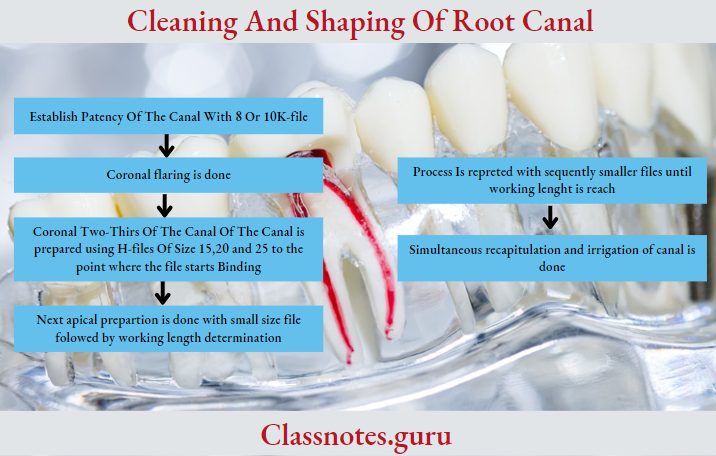
Techniques For Root Canal Preparation Advantages
- Shaping is easier
- Elimination of the bulk of the tissue, debris, and micro-organisms from the the coronal and middle third before apical shaping.
- Minimizes debris extrusion
- Better access and control over apical enlarging instruments
- Better penetration of irrigants
Question 2. Enumerate various techniques of canal preparation. Write in detail about the step-back technique.
Answer.
Obturation Of Root Canal
Techniques For Root Canal Preparation:
- Step-back technique:
- Conventional step-back
- Passive step-back
- Crown down or step down technique and its modifications
- Crown down pressure less
- Double flare
- Balanced force
- Hybrid technique
Techniques For Root Canal Preparation Step Back Technique:
- It involves the preparation of the coronal two-thirds of the canal first followed by a middle and apical third of the canal
Techniques For Root Canal Preparation Step Back Technique Stage 1:
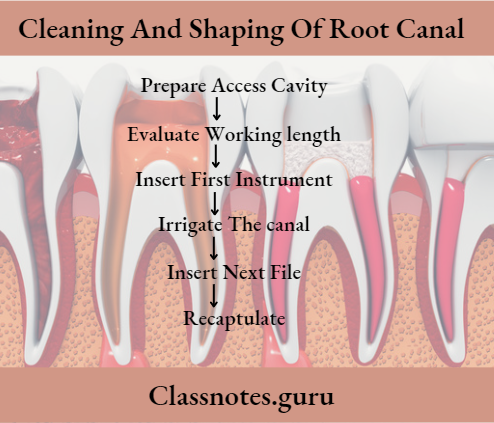
Techniques For Root Canal Preparation Step Back Technique Stage 2:
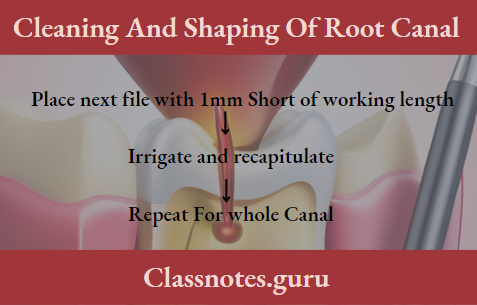
Example: For working length 22mm and the first file used is No-20

Root Canal Preparation Techniques
Techniques For Root Canal Preparation Step Back Technique Advantage:
- More flare at the coronal part
- Popular technique
- Ability to prepare a proper apical stop before preparation of the middle third and coronal third of the root canal
Techniques For Root Canal Preparation Step Back Technique Disadvantages:
- Difficult to irrigate
- Chances of pushing debris periodically
- Time-consuming
- Iatrogenic errors


Cleaning And Shaping Of Root Canal Short Essays
Question 1. Crown Down Technique.
Answer.
Crown Down Technique
It involves the preparation of the coronal two-thirds of the canal first followed by a middle and apical third of the canal.
Crown Down Technique Advantages
- Shaping is easier
- Elimination of the bulk of the tissue, debris, and micro-organisms from the coronal and middle third before apical shaping
- Minimizes debris extrusion
- Better access and control over apical enlarging instruments
- Better penetration of irrigants
- Enhances tactile sensation
- Coronal flaring
- Removes debris coronally
- Straight line access
- Decreased frequency of blockage
Obturation Of Root Canal
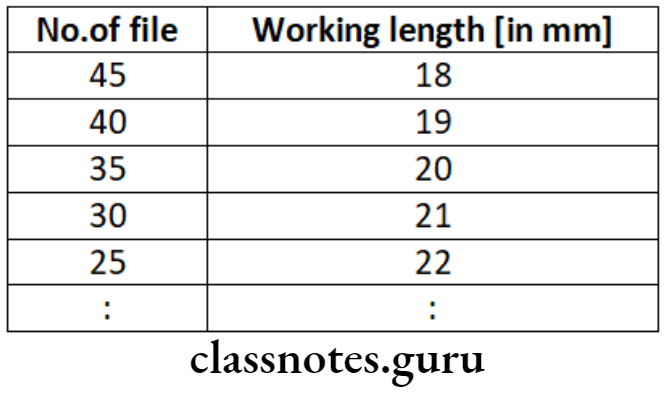
Root Canal Instrumentation Methods
Question 2. Balanced force technique.
Answer.
Balanced Force Technique Steps:
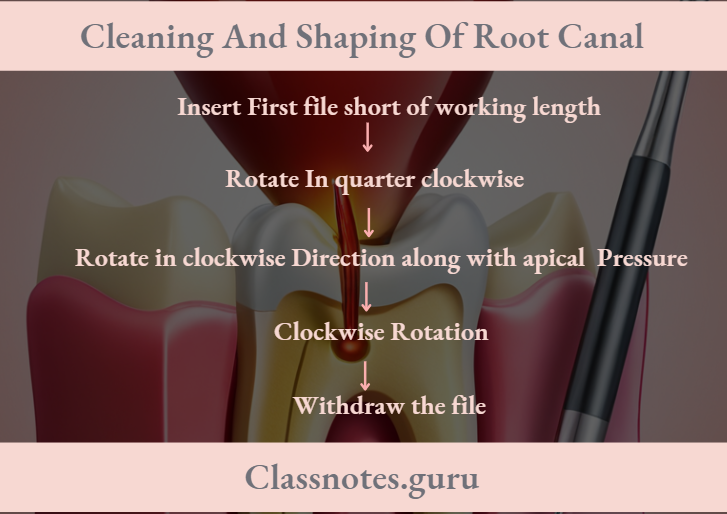
Balanced Force Technique Uses:
- Engage a small amount of dentin
- Shear off dentin
- Loosen the debris
Balanced Force Technique Advantages:
- Lesser canal transportation
- Can manipulate files at any point
- File cutting at the apical end
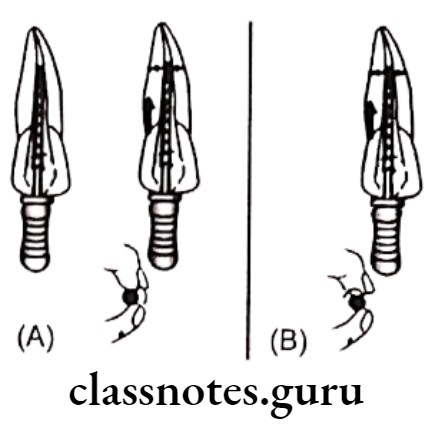

Endodontic Shaping And Cleaning
Cleaning And Shaping Of Root Canal Viva Voce
- Recapitulation is returning to a small instrument from time to time before advancing to a larger size
- Recapitulation prevents the packing of dentin filling and ensures patency of the root canal through the apical foramen
- Biomechanical preparation should provide smooth, funnel-shaped tapered walls for obturation
- Step back technique is beginning the preparation at the apex and working back up to the canal coronally with larger and larger instruments
- Step down technique begins coronally and the preparation is advanced apically using smaller and smaller instruments
